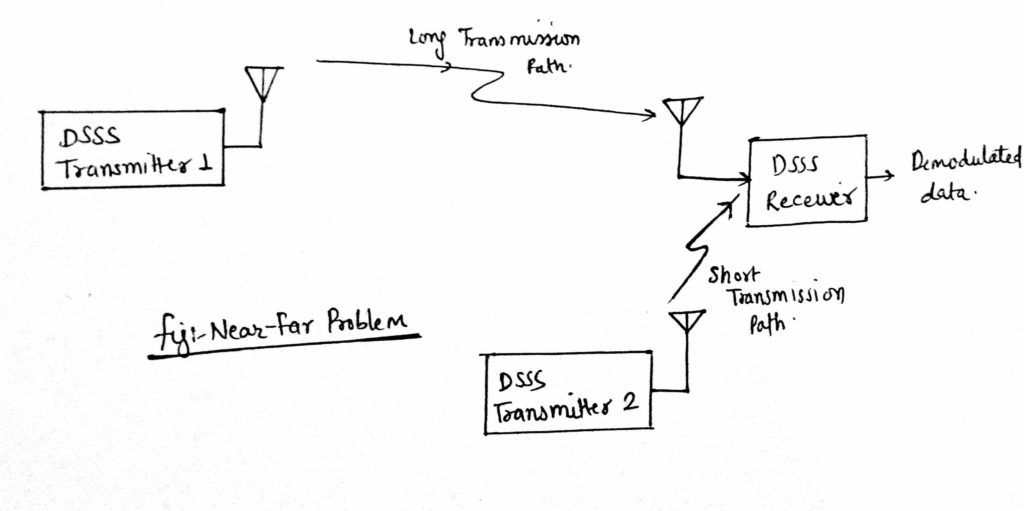According to this, the signals near to the receiver are received with less attenuation (high power) than signals far away and create interference to other users.
1. It occurs when two or more DSSS transmitters transmits the signal towards a DSSS receiver. Power of the spread-spectrum signals transmitter is the same at the antenna of each DSSS transmitter.
In the figure, we can see that two DSSS transmitters transmit the signal towards a DSSS receiver, transmitter 2 (TX2) being closer to the receiver that transmitter 1 (TX1).

2. However, the two signals at DSSS receiver antenna have different power levels due to paths between the two transmitters and the receiver are of different lengths.
3. From the figure, we can see that the power of signal coming from TX1 is lower than that of the signal from TX2 as TX1 is farther away from the receiver than TX2.
4. This is a serious problem when the DSSS receiver is set to demodulate the signal coming from TX1 because the power level of this signal is lower than signal coming from TX2.
5. Since any spread-spectrum signal other than the desired one produces interference similar to that caused by noise, this results in a poor S/N ratio at the DSSS receiver input. Consequently, errors appear in the recovered data when the process gain of the system is not sufficient to overcome S/N ratio deficit observed at the DSSS receiver input.
(A) Near-Far Problem in Uplink of CDMA:
This problem is encountered in CDMA cellular-telephone uplink networks.
1. In such network, each cellular telephone set is a DSSS transmitter that transmits a spread-spectrum signal towards the base station (DSSS receiver).
2. The power level of each spread-spectrum signal receiver depends on the distance that separates the corresponding cellular telephone set from the base station.
3. This problem can be mitigated by having each cellular telephone set make its output signal power proportional to the distance that separates it from the base station.
4. Due to this, the cellular telephone sets which are near to base station will reduce their output signal power. Conversely, the sets which are far away from the base station will boost their output signal power. The net effect is that the power levels of all the spread-spectrum signals received at the base station are approximately the same.
5. Power control in cellphones also reduces the average energy consumption.
(B) Near-Far Problem in Downlink of CDMA:
This problem does not occur in the downlink of CDMA cellular telephony networks.
1. This is because the DSSS transmitters in the base station use special orthogonal codes (e.g. Walsh codes) instead of pseudo-random code sequences to produce the various spread-spectrum signals and discriminate between the multiple users.
2. These orthogonal codes provide perfect cross-correlation i.e. the cross-correlation values are null when the codes are compared to each other. This prevents interference between multiple spread spectrum signals transmitted by the base station.
3. For the special codes (used in DSSS transmitters of the base station) to remain orthogonal, perfect synchronization between the codes are absolutely required. This is possible in the downlink because all codes are produced at the same location and transmitted from this same location (i.e. base station).
4. Due to conditions mentioned in (3), orthogonal codes are not used in the uplink of CDMA cellular telephone networks.
